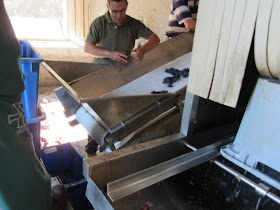The Douro wine region runs from Mesao Frio, about 100 km inland from Porto, to Freixo do Espada a Cinto on the Spanish border, a distance of approximately 70 km. The 250,000 hectares of the Douro are broken down into three sub-regions: Baixo Corgo, Cima Corgo, and Douro Superieur.
 |
| Source: pinalta.com |
Baixo Corgo is the westernmost of the sub-regions and, being closest to the Atlantic, is also the coolest and wettest. This sub-region runs eastward along the Douro from Barquaros/Barro to Régua, where the Corgo River flows into the Douro. Baixo Corgio has a surface area of 45,000 hectares of which 14,582 are under vine. Cima Corgo runs between the Corgo River and the Valeria Canyon and covers 95,000 ha (20,969 under vine). This sub-region is centered around the town of Pinhão, and is considered the heart of the broader Douro producing, as it does, most of the region's high-quality Port. Douro Superieur, the area to the east of Valeria Canyon, is the warmest and most rugged of the regions. It has a surface area of 110,000 hectares, 10,175 of which are under vine.
The Douro climate is continental with hot, dry summers and bitingly cold winters but is protected from the cool Atlantic winds by the Marāo and Montemuro mountains.
The Douro soil is primarily schist with granite at the edges. There is no natural topsoil so this has to be manufactured by breakage of the schist and the addition of fertilizer (This type of soil is called anthroposoil.). This anthroposoil is a fine dusty soil mixed with stones and bricks and this composition allows: the absorption of heat and its radiation to the grapes; rain to seep deep into the ground; vine roots to dive vertically into the ground in search of that moisture.
Given the steepness of the hillsides, vineyards in the Douro are, for the most part, terraced. Prior to the phylloxera outbreak in 1863, these terraces were narrow, irregular, and buttressed with stone walls and had one or two vines per terrace. Vine density was low at 3000-3500 vines/hectare. The Douro was rebuilt at the end of the 19th century and the new terraces were continuous with monumental walls. They had a slight slope (for better sun exposure) and supported 6000 vines/hectare.
A third terracing system was introduced in the late 60s, early 70s in order to take advantage of the possibilities afforded by mechanization. These terraces are horizontal and are supported by earthen walls with one or two rows of vines per terrace. In the cases where there are two rows of vines, they are far enough apart to allow a tractor to pass between them. This type of system, called patamares, allows for 3000-3500 vines per hectare and is best suited for larger estates.
A non-terrace planting style is used in areas where the slopes are not very steep. In this approach the vines are planted up the hillside vertically as shown in the mid- and foreground of the below picture.
Vines are trained single- or double-Guyot and close to the ground. Constant care is required to ensure a healthy vineyard. A particular requirement is frequent spraying with copper sulfate to protect against mildew. Earth around the vines have to be loosened in March and April and and some of this loose earth is banked up against the roots to protect against the dryness of July and August.
Grapes grown in the region are primarily native varietals which are grafted onto American rootstock. The varietals suited to the harsh conditions tend to yield small, thick-skinned berries. The primary red varietals are Tourega Nacional, Tourega Francesa, Tinta Barroca, Tinta Roriz, Tinta Amarela, and Tinto Cāo. The notable white varietals are Malvasia Fina, Viosinho, Donzelinho, Rabigato, and Gouveio. The authorized maximum yield is 55 hl/ha.
Harvesting in the Douro occurs during September and October. Given the nature of the vineyards, hand harvesting is the norm with a first level of selection done in the field. The selected grapes are transported down to the winery where another level of sorting is applied before de-stemming and/or crushing.
In the case of Port production, the crushed grapes are fed into a square concrete structure where they are crushed by the treading action of human feet for rapid extraction of color and flavor from the skins. The must is fortified by the addition of 20% by volume of pure grape alcohol. This fortified port is then stored in wooden barrels until the next spring when they are shipped downriver to Vila Nova de Gaia for aging, blending, and classification.
While the region is best known for Port, the Douro is becoming a force to be reckoned with in the table wine arena. Its red wines are primarily blends of the major native varietals mentioned earlier and are notable for their complexity and richness. Its white wines are also blends while Rosés are made from light maceration of red grapes. Moscato do Douro is a fortified white wine made from the Moscatel Galego grape while Espumante do Douro -- a sparkling wine -- and Colheita Tardia -- a late-harvest wine -- round out the Douro region's offerings.








No comments:
Post a Comment